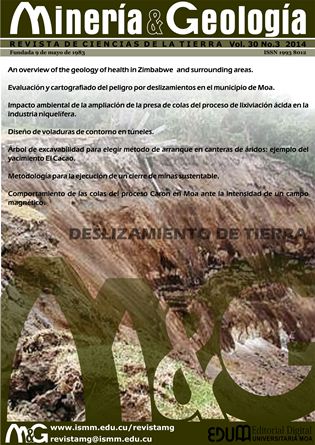A methodology for sustainable closure of mines
Keywords:
mine closure, ore exploitation, sustainable development, environmental indicatorsAbstract
A methodology with a systemic approach was designed for closing mines in a sustainable manner base d on a diagnosis carried out in seven mining regions in Cuba. This methodology contributes to planning an designing mine closure by ensuring the reduction of the environmental effect caused by ore mining activities an providing the mining industry with consistent pattern for mining planning.Downloads
References
CARVAJAL, D. & GONZÁLEZ, A. 2002: La ordenación del territorio en comunidades mineras. En: VILLAS BOAS, R. & PAGE, R. La minería en el contexto de la ordenación del territorio. Cnpq/Cyted, Río de Janeiro, 368-375.
CUBA. 1995: Ley 76. Ley de Minas. Gaceta Oficial de la República de Cuba. Volumen 3: 15-16.
CHACÓN, Y. 2012: Criterios para la ejecución del cierre de minas en el yacimiento Yagrumaje Sur. Instituto Superior Minero Metalúrgico. 92 p.
FONSECA, D. 2012: Metodología para la ejecución del cierre de minas de manera sostenible en la minería metálica cubana. Tesis de maestría. Instituto Superior Minero Metalúrgico. 99 p.
GONZÁLEZ-JIMÉNEZ, J. M.; PROENZA, J. A.; GERVILLA, F.; BLANCO-MORENO, J. A. & RUÍZ-SÁNCHEZ, R. 2009: Small-Scale Mobility Of Platinum-Group Elements During Serpentinization: Evidence From The Distribution Of Platinum-Group Minerals In Chromitites From The Sagua De Tánamo District (Mayarí-Baracoa Ophiolite Belt, Eastern Cuba). In: BORG, G. & WILLIAMS, P. (Eds.) Smart Sciences For Exploration And Mixing. Proceedings of 10Th Biennial Sga Meeting. Townsville, Australia, p. 312–319.
GUERRERO, D. & FIGUEREDO, O. 2010: Impacto ambiental del método de explotación por cámaras y pilares, aplicado en el yacimiento Las Merceditas de Cuba. En: 1ra Jornada Iberoamericana de la Red Masys. Edit. Ministerio de Industria, Comercio y Trabajo de Córdoba, Ciencia y Tecnología para el Desarrollo Cyted. Memorias. Ayacucho, Perú, 83-98.
GUERRERO, D. 2005: Sistema de indicadores mineros para la explotación sostenible de los recursos minerales. Minería & Geología 21(2): 55.
LABRADOR, M.; PROENZA, J. A.; GALÍ, S.; MELGAREJO, J. C.; TAULER, E.; ROJAS-PURÓN, A.; MUÑOZ-GÓMEZ, N. & RODRÍGUEZ-VEGA, A. 2006: Minerales de Mn-Co-Ni en las lateritas de Cuba Oriental: resultados preliminares. Macla 6: 281-284.
LEWIS, J. F.; DRAPER, G.; PROENZA, J. A.; ESPAILLAT, J. & JIMÉNEZ, J. 2006: Ophiolite-Related Ultramafic Rocks (Serpentinites) In The Caribbean Region: A Review Of Their Occurrence, Composition, Origin, Emplacement And Nickel Laterite Soils. Geol. Acta. 4: 237–263.
LÓPEZ, KRAMER J.; GANDARILLAS, J.; ACEVEDO, E. & MOREIRA, J. 2007: Mineralogía y geoquímica: su efecto en los problemas ambientales, procesos tecnológicos, la minería y desechos urbanos. Ciencias de la Tierra y el Espacio 7.
MARTÍNEZ-SILVA, R. 2012: Explotación minera. Conferencia. Instituto Superior Minero Metalúrgico. 89 p.
MILIÁN, M. E. 2012: Procedimiento para la rehabilitación minero-ambiental de yacimientos piríticos polimetálicos cubanos. Tesis doctoral. Instituto Superior Minero Metalúrgico. 100 p.
MONTERO, J. M. & SALAZAR, Y. 2011: La reinserción laboral tras el cierre de minas: una vía para lograr el desarrollo sustentable en la minería. Minería & Geología 27(4): 64-87.
RAMÍREZ, B. 2011: Remoción por flotación iónica de iones cobre con amilxantato de potasio. Tesis doctoral. Instituto Superior Minero Metalúrgico.
VILLASBÔAS, R. & BARRETO, M. L. 2000: Cierre de minas: experiencias en Iberoamérica. Cyted/Maac/Unido, Río de Janeiro, 581 p.
Published
How to Cite
Issue
Section
- Authors retain copyright and guaranteeing the right magazine to be the first publication of the work as licensed under a Creative Commons Attribution-NonCommercial that allows others to share the work with an acknowledgment of the work's authorship and initial publication in this journal.
- Authors may establish separate supplemental agreements for the exclusive distribution version of the work published in the journal (eg, place it in an institutional repository or publish it in a book), with an acknowledgment of its initial publication in this journal.
- Authors are allowed and recommended to disseminate their work through the Internet (e.g., in institutional telematic archives or on their websites) before and during the submission process, which can produce interesting exchanges and increase citations of the published work. (See The effect of open access)










